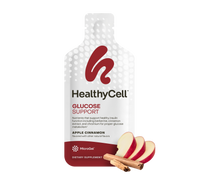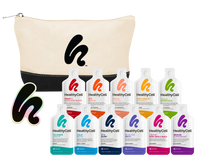Article at a glance
- Uncovering the 4 harmful ingredients hiding in our vitamins and supplements.
- How can these additives affect our health and put us at risk for long-term complications?
- A natural, non-synthetic vitamin alternative that's using natural ingredients instead of dangerous synthetic additives.
- The best natural multivitamin for our families without fillers or additives.
When we browse the aisles of the grocery store, many of us will spare a few seconds to take a glance at the ingredient profile of the items we select. But do you give your supplements the same level of scrutiny? Many of us assume that when we pick up our multivitamin that vitamins and minerals are all that we’re getting. Unfortunately, when it comes to the other ingredients added to our vitamins, what we don’t know or recognize can hurt us. Today, we’re uncovering the often-overlooked relationship between vitamins and additives, and ingredients that are added to our supplements. We're discussing a new alternative that avoids these potentially harmful “other ingredients.” Is your multivitamin a daily dose of danger? Read on to learn which vitamin additives you need to avoid when shopping for your supplements.
4 Harmful Ingredients Hiding in Our Vitamins and How to Avoid Them
The following dangerous vitamin fillers have different harmful effects on your body.
Artificial Colors and Dyes
The addition of artificial colors and dyes in vitamins should be of particular concern to consumers. While these additives present a host of potential health complications, they add no nutritional value to the supplement beyond aesthetic appeal. Considering that these dyes have been linked to an increased risk of cancer, allergies, and hyperactivity in children, it seems fair to assume that most of us would prefer a vitamin without vibrant color if it meant a safer final product.[1,2]
With more questions than answers regarding the long-term effects of artificial colors, many have questioned the U.S. Food and Drug Administration’s lack of initiative in addressing the potential health risks associated with these dyes. In response, research conducted by the Center for Science in the Public Interest revealed that several commonly used colors contained known carcinogens (cancer-causing agents) and were linked to several aggressive forms of cancer, including kidney, bladder, testicular, brain, adrenal, and thyroid.[3] The CSPI has since petitioned the FDA to take action and implement more aggressive regulatory standards in regards to the use of artificial colors, which have already been the subject of stringent policy changes in the United Kingdom. In fact, the European Union has now passed legislation that requires brands to phase out all harmful dyes as well as label all products that use these colors. With no nutritional benefit and the baggage of health and safety concerns, these colors are best left out of our nutritional supplements, or any consumables for that matter.
Magnesium Stearate
When vitamin tablets are made, manufacturers use magnesium stearate as a lubricant to prevent the nutrient particles from sticking to the equipment when the powders are compacted into solid tablet form. However, a closer look at the potential toxicity of this ingredient reveals that this is an additive that is better left out of our supplements.
As the product of saturated fat and magnesium, this chalk-like additive comes from the hydrogenation of cottonseed, canola, or palm oils. Each of these highly processed oils has been singled out as a risky food additive due to several glaring drawbacks.
- Cottonseed oil - As a trans fat, cottonseed oil is linked to an increased risk of developing heart disease.[4] Additionally, cottonseed has the highest levels of pesticides out of all other commercial oils.
- Canola oil - This oil presents a high risk of genetic modification, with estimates as high as 90% of all canola oil undergoing genetic engineering.[5,6] Canola oil has also been associated with an increased risk for cardiovascular disease and plasma lipid levels, and a reduction in antioxidant status.[7]
- Palm oil - With a fatty acid profile that includes 50% saturated fats, palm oil has been linked to an increase in LDL bad cholesterol.[8] Outside of the posed health problems, palm oil production has played a massive role in global deforestation and the loss of global biodiversity.[9]
You may be wondering what place a hydrogenated oil has in your multivitamin to begin with, and the answer is that it shouldn’t.[10] Unfortunately, hydrogenated oil is not the only pitfall of magnesium stearate. Researchers in Japan found that this additive had a dark side beyond the saturated trans fat profile, revealing that the ingredient was a formaldehyde-causing agent.[11] These associated caveats for magnesium stearate unearth enough concern to have consumers questioning any supplement that lists the excipient on the label.
Sodium Benzoate
One of the most widely used synthetic additives within the food, beverage, and supplement categories, sodium benzoate acts as a preservative to extend product shelf life and stability. In addition to preventing the growth of bacteria and other microbes, this additive is also used to make vitamin tablets smooth and transparent, allowing for rapid breakdown once swallowed. While useful from a process and manufacturing perspective, the deleterious effects of sodium benzoate should be cause for alarm as an ingredient in your multivitamin.
When sodium benzoate reacts with Vitamin C, it can convert to benzene, a known carcinogen.[12] This reaction is further amplified by certain external conditions such as length of storage and exposure to light and heat, which can be unavoidable during the manufacturing and packaging process. The reaction between the additive and the vitamin is not the only way sodium benzoate poses a threat to consumers’ health, as research has suggested the genotoxicity of isolated sodium benzoate. The findings indicate an increased risk of cellular damage and DNA mutation following exposure to the ingredient, providing further evidence against the preservative’s safety.[13] While the ingredient may offer a longer shelf-life, the possible risk to human life should be incentive enough to keep sodium benzoate out of our supplements. For these reasons, Panera Bread and Wholefoods has banned the ingredient from their foods.
Titanium Dioxide
The final addition to our list of dangerous additives is another ingredient used in vitamins for its aesthetic properties. Titanium dioxide is an ingredient used to provide a clean, white appearance to pills, powders, and tablets. Is titanium dioxide in vitamins harmful? The answer is: yes. Titanium dioxide in vitamins not only presents many health risks to consumers who take multivitamins but it has also been linked to health complications for workers involved in the production. One study found that when titanium dioxide was inhaled, it resulted in pulmonary damage to the micro-fixtures of the lungs, significantly increasing the rates of lung disease.[14]
As concern over the additive grew, further research was conducted to weed through additional health implications. One such study exposed titanium dioxide as a nephrotoxic substance linked directly to kidney damage as the result of altered gene expression, inflammation, and increased oxidative stress.[15] A second study examined the impact of titanium dioxide on the gastrointestinal tract and revealed that the additive was associated with pronounced inflammation of the small intestine. This is hugely problematic when you consider that digestive disorders and related dysfunction are a current epidemiological crisis, with millions suffering from inflammatory diseases of the GI tract, including IBS, Crohns, and Celiac disease.[16] Additionally, titanium dioxide’s impairing effect on the small intestine limits the effectiveness of supplements since this is where the majority of vitamin and mineral absorption occurs. As the scientific community continues to expose the health risks associated with titanium dioxide, once again, we find ourselves asking whether or not the visual allure of our vitamin is worth the price of safety.
With hundreds of supplements available asserting their safety and efficacy, it can be disconcerting to learn that many of these brands have been using these ingredients and labeling them in the fine print of the “other ingredients” section. he vitamin consumer deserves peace of mind, knowing that their supplement provides no risk to their safety. On top of that, a supplements should not become an equation in which we weigh the health costs and benefits. With this in mind, the team behind Bioactive Multi by Healthycell developed a daily multivitamin with healthy “other ingredients.”.
Read on to learn how this MICROGEL™ formulated product is changing the form of your multivitamin by going pill-free, and improving the function by increasing vitamin absorption.

Bioactive Multi: A Gel, Free of Harmful Fillers, Full of Essential Nutrients, Multivitamin
Bioactive Multi in gel form is a more natural approach, 100% free of synthetic binding glues, artificial colors, fillers, coatings, lubricants, and anti-caking agents. Rather than relying on synthetic fillers and binding agents to round out the ingredient profile, Bioactive Multi by Healthycell offers “other ingredients”. So what are some of these healthy “other ingredients” that make our product superior vitamins without fillers or additives?
-
Oat Beta Glucan - This heart-healthy soluble fiber not only aids in healthy digestion, but it also has been shown to lower cholesterol. [17] This healthy added ingredient is also advantageous as a component of the gel formula, giving the Bioactive Multi a pleasant consistency that’s perfect for this grab-and-go multivitamin gel.
-
Acacia Gum - Another ingredient that offers several health benefits while improving the texture and consistency of the MICROGEL. As an all natural, plant-derived fiber source, acacia gum has been shown to reduce body fat and lower total body mass index in healthy individuals as a result of improved regularity and digestion.[18]
-
Citrus Pectin - This incredible fiber source is obtained from the peel and pulp of various citrus fruits. In addition to improving digestion and gut health, this ingredient has been shown, in larger doses, to combat cancer and inhibit tumor cell growth while enhancing the efficacy of chemotherapy treatment.[19]
A closer look at the ingredient label for Bioactive Multi shows several other striking differences between the advanced microgel formula and traditional supplement pills. You won’t find any artificial colors or flavors labeled with foreign names and numbers. Instead, the Bioactive Multi gets its sweet berry flavor and pink hue from sources you can recognize (and pronounce). Sweetened with low glycemic and sustainably harvested palmyra nectar and colored by berry fruit extract. The gel formula provides an effective way to deliver vitamins and minerals in the most bioavailable state using these additional ingredients, which undergo a rigorous screening process to determine that everything is 100% free of contaminants, including pesticides, herbicides, and heavy metals. While this step is often neglected by most supplement brands, it’s the only way to ensure that the final product is both safe and effective.
As multivitamin consumers, the goal is to find a product that safeguards our health by filling in our nutritional gaps. But with “dirty” “other ingredients” finding their way into standard supplements, we have to ask ourselves, is our supplement causing more harm than good to our health? Luckily, Bioactive Multi by Healthycell, or the vegan version Vegan Essentials, offers a multivitamin that is as pure as it is powerful, using high-quality ingredients that deliver an effective dose of essential vitamins and minerals. It’s time to shine the spotlight on the dangerous ingredients hiding in our supplements, for the sake of our health and our safety, and choose a healthier alternative.




